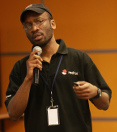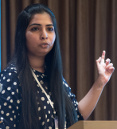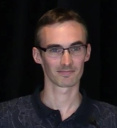[tabby title=”Steven ROSTEDT”]
STEVEN ROSTEDT
 Steven Rostedt is one of the original developers of the PREEMPT_RT patch; he started working in 2004 with the goal of turning Linux into a Real Time designed operating system. Although, the PREEMPT_RT patch still exists out of tree, several of its features have made it into the vanilla kernel. One of these features being Ftrace, the official tracer of Linux. Steven is the main author, developer and maintainer of Ftrace. He has also created ktest.pl, which is a testing framework within the Linux kernel, and is the one responsible for the kernel build option “make localmodconfig”. Outside of development, Steven has done numerous presentations around the world. He’s also been on the Kernel Summit program committee from 2010-2016, and is currently one the Linux Foundation’s Technical Advisory Board (TAB) members, which represents the kernel community to the foundation.
Steven Rostedt is one of the original developers of the PREEMPT_RT patch; he started working in 2004 with the goal of turning Linux into a Real Time designed operating system. Although, the PREEMPT_RT patch still exists out of tree, several of its features have made it into the vanilla kernel. One of these features being Ftrace, the official tracer of Linux. Steven is the main author, developer and maintainer of Ftrace. He has also created ktest.pl, which is a testing framework within the Linux kernel, and is the one responsible for the kernel build option “make localmodconfig”. Outside of development, Steven has done numerous presentations around the world. He’s also been on the Kernel Summit program committee from 2010-2016, and is currently one the Linux Foundation’s Technical Advisory Board (TAB) members, which represents the kernel community to the foundation.
Steven joined VMware at the start of 2017 as one of the core developers at the heart of VMware’s Open Source Technology Center, focused on providing value and leadership in spreading open source expertise and culture across the company. Through VMware, Steven continues to work with various open source communities contributing his time to develop and enhance open source software.
[tabby title=”James BOTTOMLEY”]
JAMES BOTTOMLEY
 James Bottomley is a Distinguished Engineer at IBM Research where he works on Cloud and Container technology. He is also Linux Kernel maintainer of the SCSI subsystem. He has been a Director on the Board of the Linux Foundation and Chair of its Technical Advisory Board. He went to university at Cambridge for both his undergraduate and
James Bottomley is a Distinguished Engineer at IBM Research where he works on Cloud and Container technology. He is also Linux Kernel maintainer of the SCSI subsystem. He has been a Director on the Board of the Linux Foundation and Chair of its Technical Advisory Board. He went to university at Cambridge for both his undergraduate and
doctoral degrees after which he joined AT&T Bell labs to work on Distributed Lock Manager technology for clustering. In 2000 he helped found SteelEye Technology, a High availability company for Linux and Windows, becoming Vice President and CTO. He joined Novell in 2008 as a Distinguished Engineer at Novell’s SUSE Labs, Parallels (later Odin) in 2011 as CTO of Server Virtualization and IBM Research in 2016.
[tabby title=”Paolo Bonzini”]
Paolo Bonzini
 Paolo Bonzini has been working for Red Hat’s virtualization team in 2009, and is among the current maintainers of KVM, the hypervisor based on the Linux kernel, and QEMU. Prior to working for Red Hat he
Paolo Bonzini has been working for Red Hat’s virtualization team in 2009, and is among the current maintainers of KVM, the hypervisor based on the Linux kernel, and QEMU. Prior to working for Red Hat he
contributed on many other free software projects, most notably: GCC, where he probably removed more lines of code than he added; GNU sed, to which he added the “-i” option (“when I was a child, we had to use perl -i -pe!”); and the Autotools, also known as the worst build system, except for all the others.
[tabby title=”Jesper Dangaard Brouer”]
JESPER DANGAARD BROUER
 Jesper Dangaard Brouer is a principal Kernel Engineer at Red Hat with a passion for performance and scalability. Currently he is optimizing the Linux kernel network stack. And occasionally optimizing the
Jesper Dangaard Brouer is a principal Kernel Engineer at Red Hat with a passion for performance and scalability. Currently he is optimizing the Linux kernel network stack. And occasionally optimizing the
memory allocator in the Linux kernel, when it becomes a bottleneck for networking.
[tabby title=”Bartosz Golaszewski”]
Bartosz Golaszewski
 Bartosz Golaszewski has over 8 years of engineering experience in the embedded systems domain ranging from low-level, real-time operating systems, through the linux kernel to user-space programs and libraries. He has worked on international projects in a broad range of fields: bleeding edge consumer electronics, high availability systems and military applications. He has contributed significant changes to several open-source projects including the linux kernel, busybox, buildroot, sigrok and many others. Bartosz maintains libgpiod – a C library for interacting with the GPIO character device for linux – and contributes regularly to the core GPIO kernel code
Bartosz Golaszewski has over 8 years of engineering experience in the embedded systems domain ranging from low-level, real-time operating systems, through the linux kernel to user-space programs and libraries. He has worked on international projects in a broad range of fields: bleeding edge consumer electronics, high availability systems and military applications. He has contributed significant changes to several open-source projects including the linux kernel, busybox, buildroot, sigrok and many others. Bartosz maintains libgpiod – a C library for interacting with the GPIO character device for linux – and contributes regularly to the core GPIO kernel code
[tabbyending]
[tabby title=”David Woodhouse”]
David Woodhouse
 David is a Principal Engineer in Amazon’s Kernel and Operating System team, working on Linux and Xen to support Amazon EC2.
David is a Principal Engineer in Amazon’s Kernel and Operating System team, working on Linux and Xen to support Amazon EC2.
David started hacking on Linux in 1995, when he was an undergraduate at the University of Cambridge. He has since worked at Red Hat, and in Intel’s Open Source Technology Centre.
David was the primary developer of the Linux MTD subsystem for flash memory, and the JFFS2 flash file system. He also wrote the OpenConnect VPN client amongst other random distractions.
[tabby title=”Julia Lawall”]

Julia Lawall is Senior Research Scientist in the Whisper team at Inria/LIP6. Her research is at the intersection of programming languages and operating systems. She develops the tool Coccinelle and has around 2000
patches in the Linux kernel based on this work.
[tabby title=”Dodji Seketeli”]
Dodji Seketeli
 Dodji Seketeli is the maintainer of the Libabigail binary static analysis framework. He is a member of the Platform Tools Team at Red Hat.
Dodji Seketeli is the maintainer of the Libabigail binary static analysis framework. He is a member of the Platform Tools Team at Red Hat.
[tabby title=”Ezequiel Garcia”]
Ezequiel Garcia
 Ezequiel Garcia has been an active contributor of several Linux Kernel subsystems, including Video4Linux and MTD. Mostly focusing on embedded devices since 2012, he is currently working for Collabora on Linux Kernel upstream projects. Ezequiel regularly speaks about the Linux Kernel at various latin-american events, and also spoke at ELC in 2013 to present the results of a Linux Foundation CE Workgroup project on kernel memory usage analysis.
Ezequiel Garcia has been an active contributor of several Linux Kernel subsystems, including Video4Linux and MTD. Mostly focusing on embedded devices since 2012, he is currently working for Collabora on Linux Kernel upstream projects. Ezequiel regularly speaks about the Linux Kernel at various latin-american events, and also spoke at ELC in 2013 to present the results of a Linux Foundation CE Workgroup project on kernel memory usage analysis.
[tabby title=”Alexander Graf”]
Alexander Graf
 Alexander is a QEMU, KVM, openSUSE and U-Boot developer who likes to work across various CPU architectures.
Alexander is a QEMU, KVM, openSUSE and U-Boot developer who likes to work across various CPU architectures.
He started to work for SUSE about 11 years ago and since then has progressed through various subsystems. He initially wrote the SVM emulation bits in QEMU, added nested virtualization support to KVM on AMD CPUs, wrote and maintained a good chunk of the KVM support for PowerPC for a few years, maintained the QEMU PowerPC parts for about as long, initiated and still participates on ARM support in openSUSE and recently dove into U-Boot land where he now maintains the UEFI execution support.
[tabby title=”Vaishali Thakkar”]
Vaishali Thakkar
 Vaishali Thakkar has diverse set of interest in the field of tech ranging from Linux Kernel hacking to advocating about diversity and open learning to community management. She started contributing to Linux Kernel from her university days [3 years back] as an Outreachy Linux Kernel intern and later joined Oracle as a full-time kernel engineer. Currently she works as a freelance Linux Kernel Engineer with clients around the world and as a co-organizer of RGSoC with Travis Foundation. She also handles Linux Kernel projects for Outreachy program as a coordinator and when not doing paid open source work, she can be found at universities/schools/meetups evangelising about Linux Kernel, open source and open learning.
Vaishali Thakkar has diverse set of interest in the field of tech ranging from Linux Kernel hacking to advocating about diversity and open learning to community management. She started contributing to Linux Kernel from her university days [3 years back] as an Outreachy Linux Kernel intern and later joined Oracle as a full-time kernel engineer. Currently she works as a freelance Linux Kernel Engineer with clients around the world and as a co-organizer of RGSoC with Travis Foundation. She also handles Linux Kernel projects for Outreachy program as a coordinator and when not doing paid open source work, she can be found at universities/schools/meetups evangelising about Linux Kernel, open source and open learning.
[tabbyending]
[tabby title=”Frédéric Weisbecker”]
 Frédéric Weisbecker works in the “Core Kernel” team at SUSE. He has been involved in many core kernel areas over the years such as instrumentation, tracing, perf events and now focuses on timers, CPU isolation and core kernel in general.
Frédéric Weisbecker works in the “Core Kernel” team at SUSE. He has been involved in many core kernel areas over the years such as instrumentation, tracing, perf events and now focuses on timers, CPU isolation and core kernel in general.
[tabby title=”Rafael Wysocki”]
Rafael Wysocki
 Rafael maintains the Linux kernel’s power management infrastructure and the core ACPI support code. He works at Intel Open Source Technology Center and focuses on the mainline Linux kernel development. He has been actively contributing to Linux since 2005, in particular to the kernel’s suspend/hibernate subsystem, power management in general (IO runtime PM framework, CPUFreq, CPUIdle, PM QoS, system wakeup framework etc.), hot-plug infrastructure, core ACPI support, core PCI support and more. Before joining Intel he worked at the Faculty of Physics of the University of Warsaw as a lecturer and IT specialist,
Rafael maintains the Linux kernel’s power management infrastructure and the core ACPI support code. He works at Intel Open Source Technology Center and focuses on the mainline Linux kernel development. He has been actively contributing to Linux since 2005, in particular to the kernel’s suspend/hibernate subsystem, power management in general (IO runtime PM framework, CPUFreq, CPUIdle, PM QoS, system wakeup framework etc.), hot-plug infrastructure, core ACPI support, core PCI support and more. Before joining Intel he worked at the Faculty of Physics of the University of Warsaw as a lecturer and IT specialist,
he was a Linux and IT consultant and he ran a business of his own. Rafael holds a PhD in Physics from the University of Warsaw.
[tabby title=”Miguel Ojeda”]
 Miguel joined CERN in 2010 as a software engineer for the Physics department and the CMS detector, where he worked on several projects like the redesign of the beam data automatic serialization and storage systems.
Miguel joined CERN in 2010 as a software engineer for the Physics department and the CMS detector, where he worked on several projects like the redesign of the beam data automatic serialization and storage systems.
Afterwards, he worked for the Beams department on the real-time radiofrequency control systems of the Linac4, SPS, LHC and other particle accelerators.
In addition, Miguel has some fun maintaining the kernel’s drivers/auxdisplay tree and writing small C++ papers.
[tabby title=”Nicolas Planel”]
Nicolas Planel

Nicolas is a Principal Software Engineer at Red Hat, he working on Skydive project.
Nicolas started running on Linux around 1995 and hacking around 2000 when he was an undergraduate. He has since worked at MandrakeSoft, and Qosmos companies.
Nicolas is co-author of Skydive project, his main interest are around Networking technology : DPI, DPDK, OVS, SDN, OVN, … but not only, he like embedded and electronics stuff too.
[tabby title=”Jiri Kosina”]
Jiri Kosina
 Jiri is a Distinguished Engineer at SUSE and works as a Linux Kernel developer and a leader of the “Core Kernel” team at SUSE Labs department.
Jiri is a Distinguished Engineer at SUSE and works as a Linux Kernel developer and a leader of the “Core Kernel” team at SUSE Labs department.
Jiri acts as an upstream maintainer for several subsystems, with Kernel Live Patching being the most new and shiny one; Jiri has written the original kGraft code, that later in cooperation with authors of kPatch,
evolved in the current upstream live patching mechanism, which Jiri is still maintaining.
[tabby title=”Grégory Clément”]
Grégory Clément
 Gregory Clement is an embedded Linux engineer and trainer at Bootlin since 2010. He has 18 years of on the field experience in porting and operating embedded Linux on many hardware architectures. He is currently involved in the integration of Marvell Armada SoCs (both ARM 32 and 64 bit versions) in the mainline Linux kernel, acting as co-maintainer for this mvebu ARM sub-architecture. As part of this port he recently worked on pushing in mainline an SD/eMMC controller supporting these “new” high speed modes.
Gregory Clement is an embedded Linux engineer and trainer at Bootlin since 2010. He has 18 years of on the field experience in porting and operating embedded Linux on many hardware architectures. He is currently involved in the integration of Marvell Armada SoCs (both ARM 32 and 64 bit versions) in the mainline Linux kernel, acting as co-maintainer for this mvebu ARM sub-architecture. As part of this port he recently worked on pushing in mainline an SD/eMMC controller supporting these “new” high speed modes.
[tabbyending]
[tabby title=”Will Deacon”]
Will DEACON
 Will is a Senior Principal Software Engineer in the kernel team at Arm, Cambridge and co-maintains the arm64 architecture port as well as the atomics API, locking infrastructure and formalisation of the Linux kernel memory model. Outside of Linux, he is an active participant in the design of the C/C++ memory model and also the Arm architectural memory model.
Will is a Senior Principal Software Engineer in the kernel team at Arm, Cambridge and co-maintains the arm64 architecture port as well as the atomics API, locking infrastructure and formalisation of the Linux kernel memory model. Outside of Linux, he is an active participant in the design of the C/C++ memory model and also the Arm architectural memory model.
When he’s not fighting with subtle concurrency issues, Will enjoys brewing beer and catching trout on the fly.
[tabby title=”Mickaël Salaün”]
Mickaël Salaün
 Mickaël Salaün is a security researcher, software developer and open source enthusiast. He is mostly interested in Linux-based operating systems, especially from a security point of view. He develops hardened distro (CLIP OS) and has built security sandboxes (StemJail) before hacking into the kernel on a new LSM (Landlock). He is currently employed by the French Network and Information Security Agency (ANSSI).
Mickaël Salaün is a security researcher, software developer and open source enthusiast. He is mostly interested in Linux-based operating systems, especially from a security point of view. He develops hardened distro (CLIP OS) and has built security sandboxes (StemJail) before hacking into the kernel on a new LSM (Landlock). He is currently employed by the French Network and Information Security Agency (ANSSI).
[tabby title=”Timothée Ravier”]
Timothée Ravier
 Timothée Ravier is a security researcher interested in Rust, systemd, Linux kernel security, containers and Kubernetes security. He is a member of the hardware and software security lab at the French Network and Information Security Agency (ANSSI) and he currently leads the CLIP OS development team.
Timothée Ravier is a security researcher interested in Rust, systemd, Linux kernel security, containers and Kubernetes security. He is a member of the hardware and software security lab at the French Network and Information Security Agency (ANSSI) and he currently leads the CLIP OS development team.
[tabby title=”Matthias Kirschner”]
Matthias Kirschner
 Matthias Kirschner is President of FSFE. In 1999 he started using GNU/Linux and realised that software is deeply involved in all aspects of our lives. Matthias is convinced that this technology has to empower society not restrict it. While studying Political and Administrative Science he joined FSFE in 2004.
Matthias Kirschner is President of FSFE. In 1999 he started using GNU/Linux and realised that software is deeply involved in all aspects of our lives. Matthias is convinced that this technology has to empower society not restrict it. While studying Political and Administrative Science he joined FSFE in 2004.
He helps other organisations, companies and governments to understand how they can benefit from Free Software — which gives everybody the rights to use, understand, adapt and share software — and how those rights help to support freedom of speech, freedom of press or privacy.
Matthias loves playing with his children, and in his spare time assists in wilderness first aid seminars, enjoys comics like XKCD and Transmetropolitan; Monty Python and Die Ärzte.
[tabbyending]
